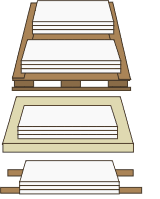

Destacking type explained

Parts may be destacked on to a station by several different methods.
0 - pallet
1 - baseboard
2 - runners
3 - variable pallet
4 - fixed baseboard
The methods are quite different a pallet is a fixed sized item with perhaps a limited number of sizes to choose from. A baseboard is a piece of material like chipboard cut specificallyl to match at stack of parts in a particular layout. The method is set at the Destacking library (for each destack record) or via the Information box 'Destack type' (at each part list).
Fixed size pallets - Fixed size pallets are placed on the station and the parts are placed on to the pallets
Baseboards - Baseboards are placed on the station and the parts are destacked on to the baseboards. The baseboard is usually of a variable size specially cut to match the size of parts it is to receive
Runners - Two timber runners are placed on the station and the parts are destacked on to the runners
Variable pallet - pallet size is determined by the size and layout of the part stacks and the pallet overhang. This is similar to the calculation of variable baseboard size.
Fixed baseboards - The part layout is adjusted to fit on to a fixed size of baseboard. For example, if the part layout is 2x2 but the fixed baseboard is only big enough to fit 1 part across the width the part layout is changed to 2x1). The minimum part layout is 1x1. This is similar to the calculation of part layout on pallets.
Destacking picture - A destacking picture describes how the part is stacked on the station. The part length and pallet/baseboard length are usually the longest sides but strictly speaking the part length is the item found in the 'Length' box in the part list and the pallet/baseboard length is the item found the 'Length' box in the destacking library. The program always show the pallet with the length edge horizontal across the page or screen.